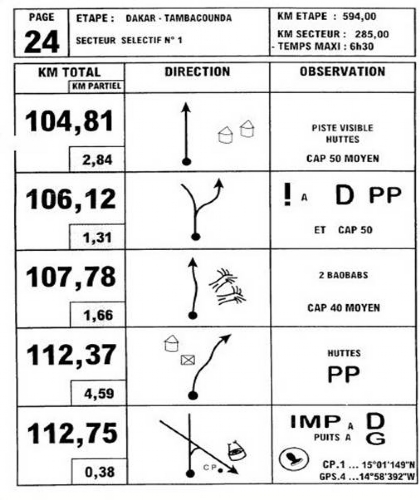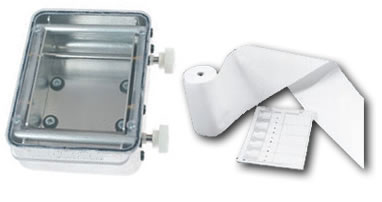Road Book notions
You will find below some basic notions and terminology about Road Books:
Dot arrow
Road book
Track
Way point
Dot arrow

Synthetic depiction of a crossing, a way point, by a set of lines representing respectively each road and their orientation compared to the course direction of the vehicle. The characteristic of the dot-arrow symbols is that the dot represents the vehicle at the entrance of the crossing and the arrow the way to follow. The other roads are usually represented for reference. The use of dot-arrow symbols exempts to cross out the roads that are not to be taken (way of doing that is sometimes applied, mainly in off-road).
Road book
In the motorcycle world, a Road Book defines a carrier, mostly under paper format, allowing to follow a pre-defined itinerary.
The level of technology of Road Books themselves and their reading accessories is significantly depending on the application: one-day road trip, circuits over several days, leisure off-road, rally and raids.
The most basic Road Book, it is the list of places, often handwritten with road numbers, which you have slipped on top of your road map in your tank bag.
But in most cases, by Road Book is understood a navigation tool representing an itinerary under the form of a succession of information on the direction changes (way points) with relative and absolute distance information. This kind of Road Book is typically the one you receive when you take part to an organised outing (Club or other organisation). Some include dot-arrow symbols that make navigation easier and instinctive (as described otherwise).
Abstract of a paper road book (rally-raid)

Enduro riders and rally-raid pilots are often using electrically powered Road Book holders. These can be handcrafted by the unit or purchased from specialised manufacturers. Mostly these units are ingenious and robust. Sometimes they may work erratically. Their principle is to have the road book unwind while you ride the road book information that was put on a paper roll. There are special paper rolls for this purpose but creating such a road book sometimes means knitting and sticking together normal pages to obtain the complete roll of the itinerary to be ridden. Such kind of road book holders is also used on road machines.
Manual road book holder and its paper roll

In order to be able to follow a paper road book, frequent resets of the odometer are required all along the course in order to avoid inaccuracies resulting from the calibration deviations between your own speedometer compared to the one use to make the road book. Electronic road books do not have this drawback while they are based on GPS-technology and not on relative distances.
Track
Usual term of the GPS-technology. A track is a sequence of coordinates representing an itinerary that the system has recorded and has to reproduce. When you read an electronic road book file, the track actually runs in background. The track checks whether you do not leave the planned course. When you create a road book by physically riding it, you record the track and generate the way points at each direction change.
Way Point
Another usual term in GPS-technology. A way point is typically a direction change. In road books, to each way point corresponds either a written instruction as to the direction to follow, either a ball arrow symbol with the necessary odometer information to reach the next way point. In the process of creating an electronic road book, the correct registration of the way points by the road book maker is a key item ensuring the quality of his work. He can either help himself by making sketches that he will later convert in dot-arrow drawings or, if he does not want to stop, he can reconstruct the topology based on the graphical editor.
|